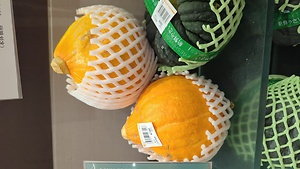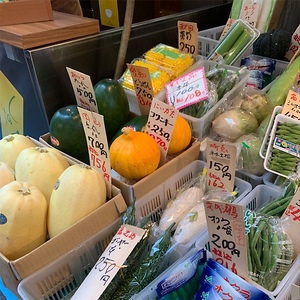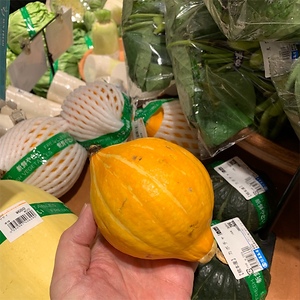


Colinky Squash
Estimated Inventory, lb : 0
Description/Taste
Colinky squash is a small to medium varietal, averaging 16 to 18 centimeters in length, and has a round, oblong, to tear-drop shape with a pointed top and a thin, light brown stem. The skin is semi-thin, easily peeled with a knife, and has a smooth, lightly ridged feel with several shallow vertical grooves extending the length of the squash. The skin also appears in shades of bright yellow with pale yellow stripes, ripening to a golden yellow-orange hue with maturity. Underneath the surface, the yellow flesh has a firm but soft feel with a succulent, crisp, and tender consistency reminiscent of cucumber or young bamboo shoot. In the center of the flesh, there is also a large cavity filled with spongy, stringy, and cottony fibers encasing teardrop-shaped, flat yellow seeds. Colinky squash has a refreshingly mild, subtly sweet, and earthy flavor.
Seasons/Availability
Colinky squash is available in the late spring through summer.
Current Facts
Colinky squash, botanically a part of the Cucurbita genus, is a Japanese squash belonging to the Cucurbitaceae family. The squash was created in the late 20th and early 21st centuries and was selected as a commercial cultivar for its size, appearance, and texture. Colinky squash is known by several name variations, including Kolinkey, Kolynkie, Colin Key, Konrinki, Korinky, and Korinki, and is sometimes known as a Western pumpkin and Salad pumpkin. The squash is distinct from other varieties as its skin and flesh are edible and can be consumed raw. Colinky squash is traditionally harvested when it is young and tender and has a mild, subtly sweet flavor used in a wide array of fresh and cooked preparations.
Nutritional Value
Colinky squash is a source of fiber to regulate the digestive tract, vitamin C to strengthen the immune system while reducing inflammation, and beta-carotene, a pigment converted into vitamin A in the body to maintain healthy organ functioning. The squash also provides B vitamins to stabilize metabolism, potassium to balance fluid levels within the body, and other nutrients, including copper, calcium, folate, and iron.
Applications
Colinky squash has a mild, subtly sweet flavor suited for raw and cooked preparations. The skin and flesh of the squash are edible and can be consumed fresh in salads. Colinky squash can be thinly sliced, peeled, or shredded and combined with leafy greens, carrots, daikon radishes, cabbage, fresh herbs, and fruits such as papaya and peaches in side salads and main dishes. Chefs value the squash’s ability to be used raw, using thin slices layered and rolled with prosciutto to create edible roses, or the squash can be cubed, sprinkled with salt, and consumed as a snack. Colinky squash can also be incorporated into sandwiches, blended into dressings, pureed into sauces, or tossed with boiled eggs to create a savory dish. In addition to raw preparations, Colinky squash can be stir-fried, cooked into soups and curries, or mixed into pasta, risotto, or rice dishes. The squash can also be sauteed in brown sugar, butter, and sage as a savory-sweet side dish, combined into ratatouille or simmered into jam. In Japan, Colinky squash is popularly mixed into chijimi fried pancakes, incorporated into kinpira, a shredded dish of ingredients sauteed with sesame oil, soy sauce, mirin, and sake, or battered in tempura and fried. The squash is also pickled as a tangy condiment, storing for extended periods. Colinky squash pairs well with hemp seeds, cucumber, radish, carrots, fruits, aromatics including garlic, chile peppers, shallots, and onions, honey, vinegar, miso, sesame, and herbs such as parsley, cilantro, mint, or basil. Whole, unwashed Colinky squash has a short shelf life and will only keep for one week when stored in a plastic bag in the refrigerator.
Ethnic/Cultural Info
Colinky squash has recently become a favored item for carving in Japan. The squash’s soft, thin skin allows chefs to cut directly into the surface of the fruit using a knife, and these carvings are used as decorative elements to enhance the dining experience. Vegetable carving is traced to ancient times in Japan, and the art of carving is known as mukimono. Legend has it that mukimono was created from the need for enhancing the visual presentation of a meal. In ancient Japan, food was often served on unglazed pottery. These clay serving vessels were covered in leaves before plating food to improve hygiene, and over time, chefs began to cut designs or fold the leaves to develop a memorable experience. Mukimono increased in popularity during the Edo Period during the 16th century and has also become a favored culinary art showcased through social media platforms in the modern-day. Colinky squash is often carved into traditional shapes, including flowers and leaves, but it has also been shaped into modern designs such as turtles, birds, and other animals, geometric shapes, or engraved with symmetrical patterns. The squash can also be carved into an edible serving bowl, ranging from bowls with designs on the outside to bowls that have been completely transformed into a see-through, basket-like pattern.
Geography/History
Colinky squash was developed in Japan in 2001 by the Sakata Seed Company, a well-known breeder and developer. The variety was created from a cross between Uchiki Red Chestnut, a Japanese squash, and B625, an Australian variety, and was selected as a modern squash cultivar, valued for its tender, edible flesh and skin, bright coloring, and succulent texture. In 2002, Colinky squash was registered by Yamagata Cell Top and Sakata Seed Company and was introduced to Japanese consumer markets in the Yamagata prefecture in northern Japan. Today Colinky squash is mainly found in Japan and is grown in the Iwate, Yamagata, and Hiroshima Prefectures.
Recipe Ideas
Recipes that include Colinky Squash. One
| Cook Yoga Travel |
|
Raw Colinky squash tart |












